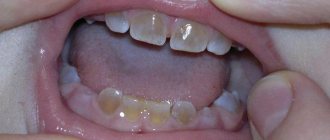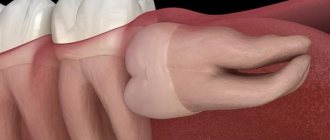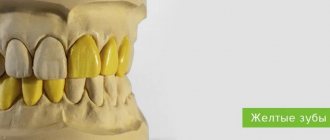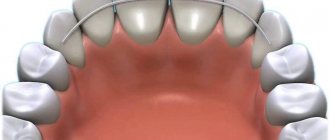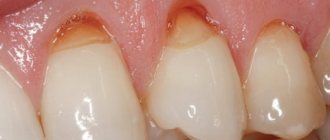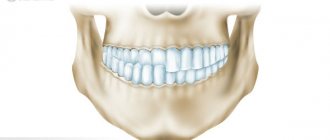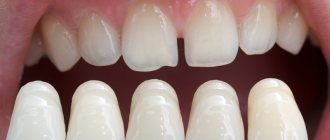The first signs of yellow teeth may appear in a child with the appearance of the first molar. At this stage, parents should be careful and seek advice from a pediatric dentist. If you exclude all factors that influence the darkening of tooth enamel, then it is quite possible that you will be able to correct the natural tone of the tooth enamel of growing teeth. These are the factors.
- Insufficient oral hygiene. If you don't supervise your baby and brush twice a day daily, plaque buildup can negatively impact the shade and formation of your baby's yellow molars.
- Correction of baby food. If a child consumes large quantities of coloring juices (carrots, pomegranates, cherries), pigment may be deposited on the hard tissue of the teeth. If the tint does not disappear within a day, then it is better to exclude such “natural” juices from your baby’s diet. The consumption of sweet and flour products is also important. It is sometimes difficult for a child to refuse sweets, but consuming sweets too often can directly affect the color of tooth enamel. Carbohydrates are a breeding ground for pathogenic bacteria, which produce acids during their life. It is these acids that destroy tooth enamel.
- Taking tetracycline antibacterial drugs. Certain medications can affect the color of enamel. This applies to both the use of medications by the baby himself and the use of medications by the mother during pregnancy. If the first signs of darkening appear during treatment of a child, you should consult a doctor and, possibly, replace the drug with another group of antibiotics.
- Enamel hypoplasia. Only the thin coating of the crown—tooth enamel—has a milky white color. Beneath it are darker tooth tissues - the so-called dentin. It is the translucency of dentin that causes the yellowish or bluish tint. If the enamel layer is insufficient, which sometimes happens in children as a pathology, then the dentin shows through quite strongly, and the teeth acquire a dirty yellow tint. It is not always possible to eliminate this fact. The dentist may prescribe an additional calcium supplement for your baby to support the development of tooth enamel. However, this is not a radical measure, so it is worth waiting until the child’s dentition is fully formed and then choosing a correction method.
- Poor quality drinking water. Large amounts of iron in water can cause yellowing of the enamel. If this situation occurs among all residents of a given region, then special purification filters for drinking water should be purchased. Otherwise, your child will have to put up with yellow teeth.
- Changes in enamel color while wearing braces. Correcting a child’s bite is a necessary and very important event. However, enhanced hygiene should be especially carefully monitored during this period. Plaque forms in the places where the braces are attached, which cannot be cleaned with a regular toothbrush and can form a yellow stain on a child’s tooth. This can lead to darkening of the enamel or even the development of dental caries. You can cope with this problem using a special irrigator designed for cleaning teeth in hard-to-reach places. Or you can visit a dentist and have your mouth professionally cleaned.
- In rare cases, yellowing of teeth can be a consequence of a general illness in the child's body. Diagnoses such as hepatitis, fluorosis, kidney disease, and serious metabolic disorders can provoke changes in the structure of the hard tissues of the teeth. In this case, the question is more about treating the root cause than its consequences.
Causes of yellow teeth
Most often, children's teeth turn yellow due to parental neglect. They must understand that they need to take care of their oral cavity from the moment the first tooth emerges. In advanced conditions, plaque removal will be required. The causes of yellowness may be hidden in acquired diseases. The color of children's crowns is negatively affected by jaundice, as brown spots appear. Also, a dark shade may appear due to problematic digestion.
As a result of mechanical damage, the enamel may crack or chip. And, as a result, yellow spots appear. The pathology is caused by hypoplasia of the enamel layer, under which there is yellowish dentin. In this case, the teeth are already yellow at the time of eruption. Factors in the development of hypoplasia include pathologies of the mother during pregnancy. After all, organs are laid down and mineralized in the womb. Precipitating factors include maternal infections and toxicosis, birth trauma, and prematurity of the infant.
Rare diseases can also be to blame for yellowness. We are talking about dentinogenesis imperfecta and amelogenesis. The first pathology develops with a congenital disorder of the dentin development process. And the second disease is associated with improper formation of the enamel layer. Most often, such anomalies are characteristic of girls. Their treatment is complex and must be started immediately after the units appear.
Eating junk food
Often, yellow teeth in a child are the result of food dyes. This situation is caused by frequent consumption of pumpkin and carrot juice. Orange dyes penetrate microcracks very easily, causing the crown to turn yellowish. Coloring vegetables, berries and fruits, for example, beets or blueberries, also work. Their bright color stays on little teeth!
It is necessary to remember the negative impact on acid units. It could be a too sour apple or applesauce, orange or lemon juice. They can cause acid necrosis. The cracks that appear are immediately filled with dyes and the crowns become dark. It should be noted that iron also affects the shade of enamel. Most often, this situation is typical for well water in rural areas where there are no filters.
A separate conversation about sweets, baked goods, candies, chewing gum with sugar. Particles of these products that remain in the mouth provide a favorable environment for bacteria and pathogenic microorganisms that settle in plaque. Here it is appropriate to remember that the most harmful food is its increased dose!
Poor oral hygiene
Children who do not know how to brush their teeth are most at risk of developing unsightly stains. Therefore, it is important to teach your child how to properly use a brush and toothpaste. It is good if parents keep this process under control. Well, when the situation is difficult, you need to have your teeth cleaned of yellow plaque by a professional hygienist. Only daily procedures at home will consolidate the results and prolong the effect.
- The first incisors are wiped with a soft bristle brush after any feeding.
- When the baby learns to hold the hygiene instrument himself, he needs to be taught the rules of brushing his teeth.
- The brush and paste are selected according to age. The dentist will provide invaluable assistance with this.
- Parents should monitor the cleaning process until 8-10 years of age.
- Children with orthodontic elements are subject to special monitoring. Monthly professional cleaning is the norm for these guys.
With improper care, unsightly plaque, stones and plaques appear. This worsens the child’s appearance and increases the risk of developing dental diseases. We are talking about caries, gingivitis, periodontal disease, and pathologies of the ENT organs.
Taking medications
Some medications cause enamel discoloration. This group of antibiotics primarily includes tetracycline and amoxicillin. If taken by a pregnant woman, it usually causes her baby's teeth to turn yellow. Often these drugs are prescribed to children themselves, even up to one year old. Their frequent use almost always contributes to darkening of the enamel. What to do? In such a situation, hygienic cleaning of the oral cavity is indicated. Professional dentistry will correct the unsightly condition. “Tetracycline teeth” can be whitened using modern technologies. Of course, such procedures should be prescribed to the child by a doctor.
Genetic predisposition
It has long been proven that the color of units is strongly influenced by genetics. If parents have dull teeth, then it is not surprising that the same yellow spots will appear on the child’s teeth. True, the factor of heredity does not occur often, so it cannot be called determining. But you shouldn’t write off genetics either. Today, more and more medical scientists are proving its importance. When diagnosing and developing a treatment program, the dentist must take into account the genetic line so that the therapy is effective.
Poor maternal nutrition during pregnancy
During the period of bearing a child, a woman must eat properly and nutritiously in order to receive valuable microelements and vitamins from food. If the diet is unbalanced, the fetus does not develop fully. From birth, such babies have thinned enamel due to the fact that even in the womb there was a deficiency of nutrients, especially calcium, vitamin and fluoride. Brown dentin will be visible through the thin layer. This causes yellow plaque on the child’s teeth. Therefore, a prerequisite for the proper development of the fetus is the rational nutrition of its mother.
To prevent the child’s teeth from deteriorating, the mother must have enough calcium and fluoride. A powerful source of calcium is sesame. The seed must be thoroughly crushed or chewed to release the beneficial trace element. Don't forget about bananas, salmon, broccoli and olive oil. To replenish fluoride reserves, you need to include avocados, carrots, cucumbers, and dates in your diet.
Brown spots
Similar manifestations on tooth enamel are also caused by the development of hypoplasia. The disease is generally very common and, according to some estimates, affects up to 40% of children.
The causes of hypoplasia, in contrast to caries, which destroys still growing teeth, are complications during pregnancy or trauma during birth. It can also develop due to poor nutrition, digestive problems and damage to tooth enamel.
For prevention, it is necessary to monitor the condition of the mother’s teeth. You should stop artificial feeding and monitor the child’s nutrition subsequently, as well as regularly visit the dentist.
Yellowness of teeth in a child 1-3 years old
It happens that this problem is not given due attention. Parents mistakenly believe that a one-year-old child with his baby teeth does not need a dental examination. After all, these units are a temporary phenomenon, so there will be no harm from their pathology. In reality, everything is completely different. If you do not visit the dentist in a timely manner, then problems in the form of darkening of the crowns in the future will develop into serious anomalies of the oral cavity. What should parents do?
- Once the incisors appear, they need to be wiped with a damp cloth after feeding.
- When your child turns 1 year old and has 8 units, start cleaning them with a toothbrush without toothpaste. It should be small in size with nice bristles.
- After the child turns 2 years old, begin to teach him to be independent in matters of oral hygiene, then at 2.5 years he will be able to carry out this procedure himself.
Consult your doctor about the choice of baby toothpaste. After all, it is very important to approach it correctly. Do not use products that are oversaturated with flavors and dyes.
Features of superficial caries
Among the main distinctive features of superficial carious damage to teeth in children in comparison with other forms of pathologies, the following should be noted:
- only the enamel layer is affected by pathogenic formations. The dentin remains intact. With timely treatment, the risks of complications are minimal;
- the occurrence of an acute reaction to external stimuli, for example, sour and sweet foods, low and high temperatures;
- if superficial caries is diagnosed in children, treatment can be carried out without tissue preparation;
- Most often, the superficial form occurs in children aged 3-4 years and in adolescents.
Note! Initial caries and superficial caries are two completely different forms. The first appears as a small spot, the second occurs in the absence of treatment. It can be recognized by the presence of small-sized carious cavities.
Yellow plaque in children over 7 years old
Deposits discovered during school age are most often associated with improper tooth brushing procedures. It is important that a suitable brush is selected taking into account the level of sensitivity of the gum tissue. Special care is not required when performing routine procedures systematically. True, if the situation is seriously advanced, then you cannot do without a visit to the dentist. When a child is 8 years old or older, teeth cleaning using the Air Flow method is prescribed, if necessary. This procedure is safe and painless.
A harbinger of pathology is bad breath and a slippery coating on the crowns and gums. A timely cleaning procedure will prevent the mineralization of soft plaque, which often happens at this age. Refined and soft carbohydrate foods should be limited. Such products get clogged into the interdental spaces. It is useful to give children solid vegetables and fruits, for example, carrots or apples. Remember that proper hygiene is the key to oral health and the best remedy against yellow discolouration!
What to do with a child's yellow teeth
The choice of treatment technology depends on the disease and the phase of its development. Light yellowness can be removed with special pastes. More severe cases require professional cleanings by a dentist. For older teenagers, ultrasonic teeth cleaning is used. If there is a serious need to use a skeler, the procedure is carried out delicately and with caution. The cost of procedures in our center is affordable, as we always pursue a reasonable pricing policy.
At the appointment with our dentist, the child will be mentally prepared for therapy in order to prevent fear. The level of oral hygiene is determined by special indicators. Professional cleaning procedures are painless. This can be a rotating brush, which works well on both the oral and vestibular sides. After such manipulations, as a rule, a hygiene lesson is conducted in a playful way.
Preventive measures
To prevent yellowing of teeth, it is important to carry out all hygiene measures efficiently and on time. We are talking about twice daily cleaning of units, even dairy ones. It’s good if parents take their child to the dentist once every 60 days. The basis of dental health is a balanced and proper diet. As for the frequency of professional cleaning, it should be carried out once every six months. Don't forget to change your toothbrushes and toothpastes on time. Teach your child to oral hygiene from an early age, then dental problems will be minimized.
Why treat baby teeth?
Rotten baby teeth do not always attract the attention of parents. Especially if the pathological processes are painless and do not bother the child. Adults think that when the bite changes, the bad teeth will disappear by themselves, and instead of rotten teeth, normal molars will grow. Dentists warn about the fallacy of such a misconception.
Rotten milk teeth are:
- damage or destruction of tooth germs - a high risk that the root units will grow sick or not appear at all;
- early loss of primary occlusion units - leads to displacement of existing teeth, the appearance of crowding, and the formation of a pathologically abnormal bite;
- an ugly smile, an unaesthetic appearance - the appearance of complexes due to appearance in young children, decreased contact with peers, uncertainty, isolation;
- deterioration of diction - rotten, breaking teeth interfere with the correct movements of the tongue during speech, leading to a lisp, burr;
- gradual spread of infection - damage not only to the surface of the teeth, but also to the pulp, development of pulpitis, the appearance of an abscess, as well as a tendency to ENT diseases and gastrointestinal diseases.
